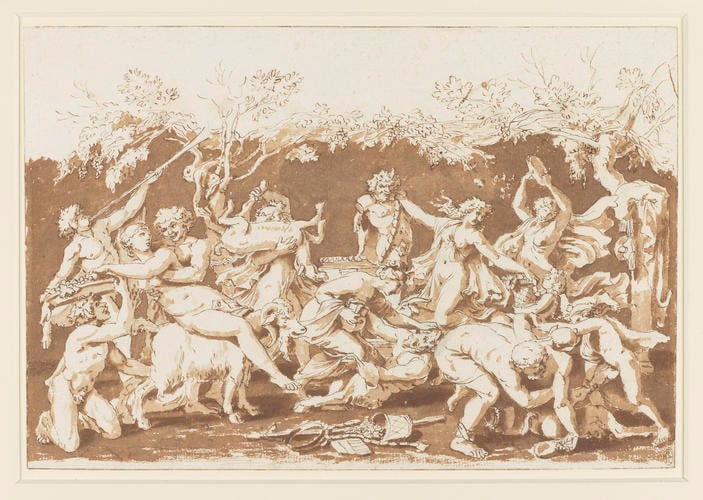-
1 of 253523 objects
The Triumph of Pan c.1635-36
Pen and brown ink, brown wash, over black chalk and stylus | 22.8 x 33.8 cm (sheet of paper) | RCIN 911995

Nicolas Poussin (1594-1665)
The Triumph of Pan c.1635-36
-
A careful study for the Triumph of Pan (London, National Gallery), painted for Cardinal Richelieu and dispatched in May 1636 (see 911905 for more details). Here Poussin tries out the full effect of the composition with the figures in their final positions, a type of finished preparatory drawing that was to become increasingly common in his work of the following decade. Any dramatic tensions that were present in the earlier preparatory drawings have been suppressed, and the result is pure decoration - the contrast in purpose between this composition and the series of Sacraments that Poussin was to paint in the following years is remarkable.
The small differences of detail between drawing and painting are less significant than the overall change in the proportions of the composition. The figure group in the painting has been compressed widthways and heightened, primarily by increasing the scale of the figures at the rear, thus destroying the internal perspective of the group and rendering it even flatter than in the drawing. This effect is compounded by the extension of the background in the painting, where the screen of slender tree trunks reads as nothing more substantial that a stage backdrop. The disturbing contrast between this blank curtain and the dense patterning of the figure group below emphasizes the last-minute nature of these adjustments. This is rather puzzling, as the paintings were commissioned for a predetermined space, and Poussin was presumably given the required dimensions from the outset, yet the preparatory drawings for the composition have no fixed proportions, as can be seen from the two sketches on the verso of 911905. It is as if Poussin became so carried away with the formal game of the composition that he lost sight of the requirements of the commission, and had to make a rather drastic and unsatisfactory adjustment to fit his "ideal solution" to the dimensions of the canvas.
The uniformly washed background of the drawing and the use of the vine along the top of the composition are, as has been noted, in direct emulation of Greek vase painting, though much of this effect is lost in the painting with the inclusion of a landscape. Nonetheless it does seem that Poussin was aiming for a certain archaism, and the rather stiff execution of the paintings (which remains the principal objection to the authenticity of the Kansas City painting of the Triumph of Bacchus) may be attributable to a sense of good manners - attempting to suppress all trace of seventeenth-century brushwork so that his pair of paintings would sit comfortably alongside the works of Perugino, Mantegna and Costa.Provenance
Cardinal Camillo Massimi (1620-1677); from whose heirs bought in 1739, for 300 scudi, by Richard Mead (1673-1754); probably presented to Frederick, Prince of Wales, by 1750
-
Creator(s)
Acquirer(s)
-
Medium and techniques
Pen and brown ink, brown wash, over black chalk and stylus
Measurements
22.8 x 33.8 cm (sheet of paper)
Other number(s)
RL 11995Alternative title(s)
Bacco Phallico